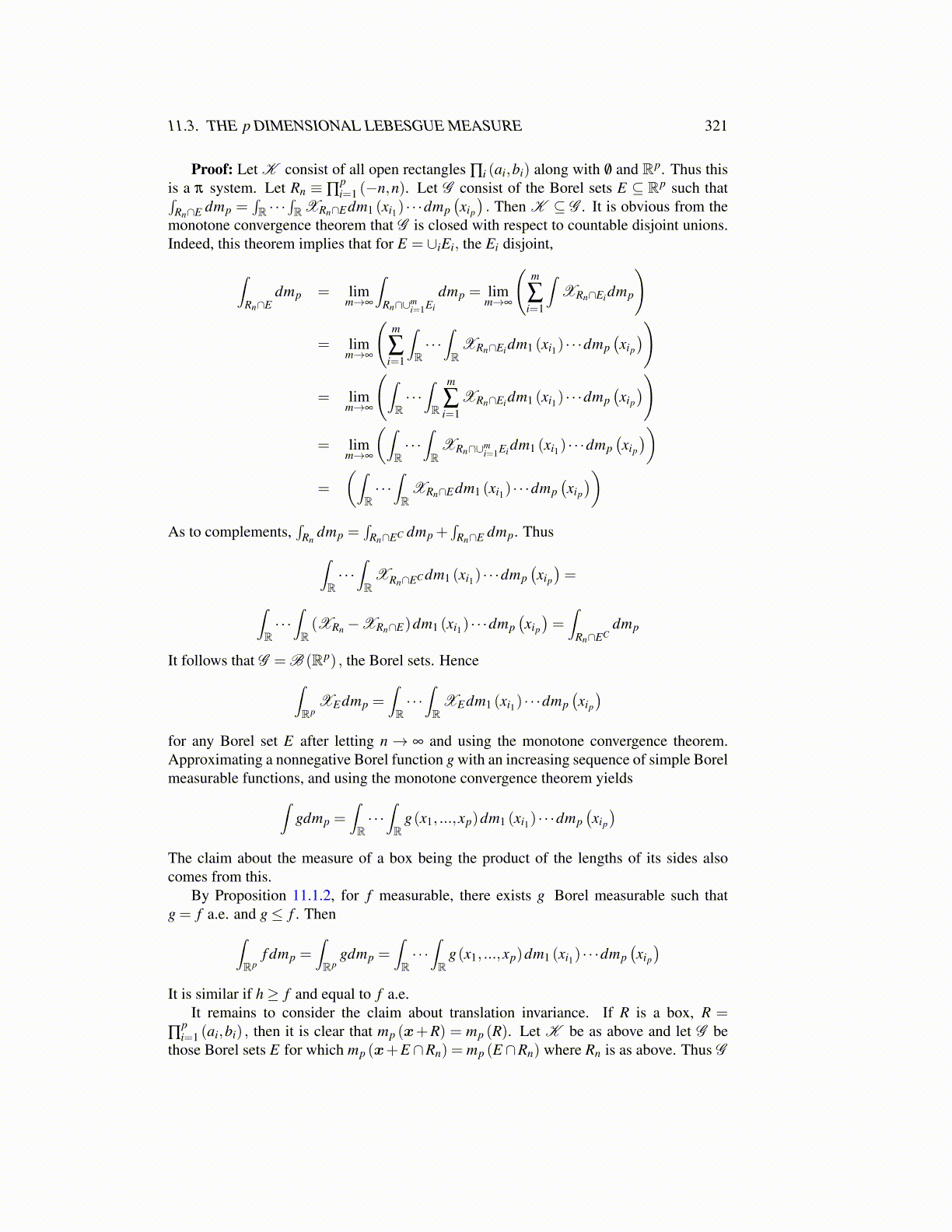
11.3. THE p DIMENSIONAL LEBESGUE MEASURE 321
Proof: Let K consist of all open rectangles ∏i (ai,bi) along with /0 and Rp. Thus thisis a π system. Let Rn ≡ ∏
pi=1 (−n,n). Let G consist of the Borel sets E ⊆ Rp such that∫
Rn∩E dmp =∫R · · ·
∫RXRn∩Edm1 (xi1) · · ·dmp
(xip
). Then K ⊆ G . It is obvious from the
monotone convergence theorem that G is closed with respect to countable disjoint unions.Indeed, this theorem implies that for E = ∪iEi, the Ei disjoint,
∫Rn∩E
dmp = limm→∞
∫Rn∩∪m
i=1Ei
dmp = limm→∞
(m
∑i=1
∫XRn∩Eidmp
)
= limm→∞
(m
∑i=1
∫R· · ·∫R
XRn∩Eidm1 (xi1) · · ·dmp(xip
))
= limm→∞
(∫R· · ·∫R
m
∑i=1
XRn∩Eidm1 (xi1) · · ·dmp(xip
))
= limm→∞
(∫R· · ·∫R
XRn∩∪mi=1Eidm1 (xi1) · · ·dmp
(xip
))=
(∫R· · ·∫R
XRn∩Edm1 (xi1) · · ·dmp(xip
))As to complements,
∫Rn
dmp =∫
Rn∩EC dmp +∫
Rn∩E dmp. Thus∫R· · ·∫R
XRn∩EC dm1 (xi1) · · ·dmp(xip
)=
∫R· · ·∫R(XRn −XRn∩E)dm1 (xi1) · · ·dmp
(xip
)=∫
Rn∩ECdmp
It follows that G = B (Rp) , the Borel sets. Hence∫Rp
XEdmp =∫R· · ·∫R
XEdm1 (xi1) · · ·dmp(xip
)for any Borel set E after letting n→ ∞ and using the monotone convergence theorem.Approximating a nonnegative Borel function g with an increasing sequence of simple Borelmeasurable functions, and using the monotone convergence theorem yields∫
gdmp =∫R· · ·∫R
g(x1, ...,xp)dm1 (xi1) · · ·dmp(xip
)The claim about the measure of a box being the product of the lengths of its sides alsocomes from this.
By Proposition 11.1.2, for f measurable, there exists g Borel measurable such thatg = f a.e. and g≤ f . Then∫
Rpf dmp =
∫Rp
gdmp =∫R· · ·∫R
g(x1, ...,xp)dm1 (xi1) · · ·dmp(xip
)It is similar if h≥ f and equal to f a.e.
It remains to consider the claim about translation invariance. If R is a box, R =
∏pi=1 (ai,bi) , then it is clear that mp (x+R) = mp (R). Let K be as above and let G be
those Borel sets E for which mp (x+E ∩Rn) = mp (E ∩Rn) where Rn is as above. Thus G